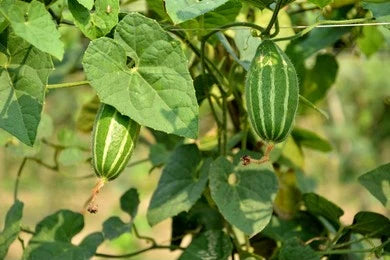Trichosanthes Dioica is the scientific name for Patola. It is commonly known by the name pointed gourd. This is one of the most nutritious cucurbit vegetables, with a huge following in the Indian market during the rainy and summer seasons. The plant is nectarous and perennial. The plant grows in the manner of a vine. Vines have a thick, pencil-like structure with ovate, oblong, cordate, unlobed, inflexible, dark green leaves. Their roots have a tube-like structure and a lengthy tap root system to regulate the plant's operations. The flowers are white and tubular in shape. This plant's flowers are dioecious. Male flowers are not strobile. The plant's stigma stays for at least 14 hours, and up to 40% to 70% of the blooms set fruits. Fruits are typically 5 to 9 cm in size and have a spherical orange-red wine hue when ripe.
But the fruits of Patola can be categorized into four types:-
- The first species is 10-13 cm long, dark green with white streaks.
- Another variety is 10-16 cm long and has thick, dark green stripes with very faint green highlights.
- Others are roundish, dark green with a white line, and 5 to 8 cm tall.
- The last one has Tapered, is green and striped, and is 5-8 cm long.
General Description
Patola, also known as Trichosanthes dioica, is a powerful medicinal herb that has been well-documented in Ayurvedic literature and modern research. Patola is referenced in various Ayurvedic literature in the treatment of severe disorders. It is also known as lulka, tikta, panduka, rajiphala, amritphala, pratika, kushthaha, meki, parvara, kulaka, nagaphala, Karkashacchada, and Tiktottama in Ayurveda.
Sespadula in English and Parwal in Hindi are common names for Trichosanthes dioica. It is widely farmed throughout India and beyond. It is a type of perennial crop that is widely accepted due to its abundance. From February to September, this plant is available for eight months of the year.
Patola is a Tagalog word that means luffa or pointed gourd. This plant belongs to the vegetable family that is common in the Philippines. This plant has a variety of vital phytochemical elements that aid plant Patola in the fight against numerous ailments. The plant's roots contain hentriacontane, trichosanthin, saponin, fixed oil, starch Colocynthin, an essential oil with terpenes, reducing sugar, and trace amounts of tannin. Patola stems include fatty acids such as linoleic, oleic, and oleo stearic or trichosanic acid, as well as Cucurbita-5, 24-dienol, which is also found in mature plants. The plant's leaves can be consumed as vegetables since they contain numerous biochemical components in acceptable ratios such as 80.5 moisture; 5.4 protein; other carbs 5.8; and mineral matter 3.0% calcium 531; 1.1 fat; 4.2 fiber; and phosphorous 73 mg / 100 g. Active ingredients found in fruits include riboflavin, vitamin C, 5-hydroxytryptamine, nicotinic acid, and thiamine.
Classification
- Kingdom - Planate
- Subkingdom - Tracheobionta
- Superdivision - Spermatophyta
- Division - Magnoliophyta
- Class - Magnoliopsida
- Subclass - Dilleniidae
- Order - Violales
- Family - Cucurbitaceae
- Genus - Trichosanthes
- Species - T. dioica
Habitat
Trichosanthes dioica, sometimes known as Patola, is a tropical vegetable crop. The crop is of Indo-Malayan origin and distributed in eastern sections of India, and to a lesser extent in other regions of Asia. In different parts of India and Bangladesh, it is called by different names, such as parwal, palwal, or parmal. Patola is an essential vegetable in this region.
Other Names
- Sanskrit name - Panduka, Rajiphala, Amritphala, Pratika, Patola, Nagaphala, Karkashacchada, Tiktottama, Lulka, Tikta, Kushthaha, Meki, Parvara, Kulaka,
- English name - Wild Snake Guard, Pointed Gourd
- Gujarati name - Patola, Patal
- Punjabi name - Parwal, Palwal
- Hindi name - Parval
- Telugu name - Kommu Potla / Chedu Potla
- Bengali name - Patol
- Marathi Name - Paraval
- Tamil name - Kambupudalai
- Kannada name - Kadu padavala kayi, Kaadu Padaval
- Malayalam name - Patolam
- Oriya name - Patal
- Urdu name - Prora
- Bangladeshi name - Potol
- Pakistani name - Palwal, Parol, Petal
- Unani name - Parwal
Ayurvedic Properties
|
|
Hindi / Sanskrit |
English |
|
Rasa (Taste) |
Tikta |
Bitter |
|
Guna (Physical Property) |
Laghu, Ruksha |
Light, Dry |
|
Virya (Potency) |
Ushna |
Hot |
|
Vipaka (Post-Digestive Taste) |
Katu |
Pungent |
Effects on Doshas
It brings kapha and Pitta into balance. Almost all Acharyas mention Patola leaf to manage Pitta Samaka, Nala to manage Kapha Samaka, and fruit as Tridosha Shamaka. Patola's roots are virechanakaraka.
|
Charak Samhita |
Vagbhata / Sushrut Samhita |
|
|
Practical Uses
- Nematocidal and Antihelmintic effects - The extracts of roots dichloromethane (DCTD), methanol (METD), and aqueous (AQTD) possess paralytic and deadly effects against worms in vitro.
-
Anti-hyperglycemic & antihyperlipidemic activity - Patola is described as a treatment for Pittaj Prameh in the Charak Samhita. As a result, T. diocia could be turned into an effective oral medicine for the treatment of diabetes and its complications.
-
Chemo Preventive Activity - Patola has chemo characteristics found in its root extracts. It reduces the harm caused by carcinogens.
-
Laxative activity - The roots have laxative action, which provides significant relief from constipation.
-
Anti-inflammatory activity - The anti-inflammatory properties of triterpenoids found in root extracts lessen inflammation.
- Cholesterol-lowering Activity - It is well known that this plant's aqueous fruit extract lowers cholesterol
- Effect on Ascites - The triterpenoid-enriched root extract reduces ascetic fluid.
Neuropharmacological functions
- Patola root properties include the ability to relax skeletal muscle as well as sedative properties.
- Patola Patra is used to treat jaundice since it is purgative.
- Patola Patra relieves coughs and strengthens the chest.
- Patola Patra is extremely efficient in treating skin disorders.
- Patola Patra enhances mouth taste, appetite, and digestion.
Parts used
Roots, Leaves, Fruits
Precautions
A higher dose causes nausea and diarrhea.

